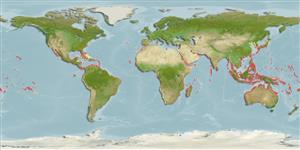Common names from other countries
Environment: milieu / climate zone / depth range / distribution range
Sinh thái học
Biển; Thuộc về nước lợ Cùng sống ở rạn san hô; Ở đại duơng, biển (Ref. 51243); Mức độ sâu 0 - 3 m (Ref. 58047). Subtropical; 43°N - 37°S, 180°W - 180°E
Worldwide distribution in tropical and warm temperate waters. Eastern Atlantic: Cape Verde and Dakar to Moçamedes, Angola (Ref. 5757); ranging further south to Namibia (Ref. 12484). Western Atlantic: Chesapeake Bay (USA), Bermuda, and northern Gulf of Mexico to Brazil (Ref. 7251). Throughout the Indian Ocean. Western Pacific: off coasts and islands from southern Japan through the East Indies to Australia (Ref. 9682). Reported from Tuvalu (Ref. 12690). Eastern Pacific: Mexico to Peru. Entire Caribbean, Antilles and South American coast to Rio de Janeiro (Ref. 26938).
Bộ gần gũi / Khối lượng (Trọng lượng) / Age
Maturity: Lm ? range ? - ? cm
Max length : 140 cm TL con đực/không giới tính; (Ref. 40637); common length : 70.0 cm SL con đực/không giới tính; (Ref. 9279); Khối lượng cực đại được công bố: 4.8 kg (Ref. 40637)
Các tia vây lưng cứng (tổng cộng) : 0; Các vây lưng mềm (tổng cộng) : 23 - 26; Tia cứng vây hậu môn: 0; Tia mềm vây hậu môn: 24 - 28; Động vật có xương sống: 86 - 93. Dark bluish dorsally, silvery white ventrally with black blotches on middle of body (Ref. 5317). Body greatly compressed laterally; anterior parts of dorsal and anal fins with high falcate lobes. Pectoral fins falcate; about 12-14 prominent dark vertical bars on body; juveniles and adults have an elevated black lobe in the posterior part of the dorsal fin.
Inhabits neritic and oceanic waters but more often found near islands (Ref. 5213). Found in estuaries (Ref. 26340), and coastal rivers (Ref. 33587). Sometimes forming large schools (Ref. 5217). Feeds mainly on small fishes (Ref. 9279). Oviparous (Ref. 205). Eggs may be found attached to objects in the water by filaments on the egg's surface (Ref. 205). Since the jaws are frequently broken, the maximum length is given as body length excluding head and caudal fin. Usually caught with the help of artificial lights (Ref. 9279). Marketed fresh and salted; smoked or frozen (Ref. 9987). Market limited due to the green-colored flesh (Ref. 5217). In females, only left gonad is developed, and in males the right gonad is small or absent (Ref. 26938).
Collette, B.B., 1999. Belonidae. Needlefishes. p. 2151-2161. In K.E. Carpenter and V.H. Niem (eds.) FAO species identification guide for fishery purposes. The living marine resources of the Western Central Pacific. Volume 4. Bony fishes part 2 (Mugilidae to Carangidae). FAO, Rome. (Ref. 9682)
IUCN Red List Status (Ref. 130435)
CITES (Ref. 128078)
Not Evaluated
Threat to humans
Harmless
Human uses
Các nghề cá: buôn bán nhỏ; cá để chơi: đúng
Các công cụ
Special reports
Download XML
Các nguồn internet
Estimates based on models
Preferred temperature (Ref.
115969): 22.6 - 29.2, mean 27.9 (based on 4228 cells).
Phylogenetic diversity index (Ref.
82804): PD
50 = 1.0000 [Uniqueness, from 0.5 = low to 2.0 = high].
Bayesian length-weight: a=0.00085 (0.00046 - 0.00157), b=3.12 (2.96 - 3.28), in cm Total Length, based on LWR estimates for this species & (Sub)family-body (Ref.
93245).
Mức dinh dưỡng (Ref.
69278): 4.2 ±0.66 se; based on food items.
Thích nghi nhanh (Ref.
120179): Trung bình, thời gian nhân đôi của chủng quần tối thiểu là 1.4 - 4.4 năm (Assuming tmax>3; K=0.6).
Fishing Vulnerability (Ref.
59153): Moderate vulnerability (40 of 100).
Climate Vulnerability (Ref.
125649): High to very high vulnerability (74 of 100).
